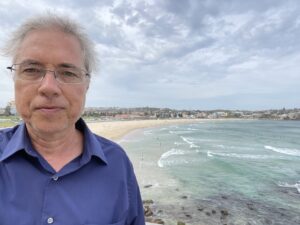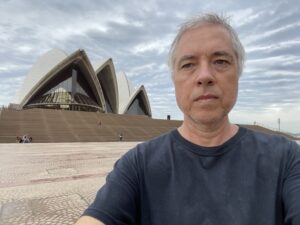- https://PayPal.Me/lukeisback
"Luke Ford reports all of the 'juicy' quotes, and has been doing it for years." (Marc B. Shapiro)
"This guy knows all the gossip, the ins and outs, the lashon hara of the Orthodox world. He’s an [expert] in... all the inner workings of the Orthodox world." (Rabbi Aaron Rakeffet-Rothkoff)"This generation's Hillel." (Nathan Cofnas)
July 2025 S M T W T F S 1 2 3 4 5 6 7 8 9 10 11 12 13 14 15 16 17 18 19 20 21 22 23 24 25 26 27 28 29 30 31
Running Towards My New Life
This started out as a vacation and it has turned into adulting. I’m spending all of my time setting up my Aussie Medicare, getting an Aussie phone, bank account, tax ID number, Aussie passport, get out my resume, apply for jobs… I make sure to run everything by wiser heads than mine…I’ve been talking to friends about the prospect of me moving to Sydney. They are all positive about it. They think it is a good fit. They, so far, don’t think I am running from something, but running towards my family and my best interests.
Ocean temperature and outside temperature are about the same in Sydney — 67 F. I went snorkeling for the first time in many decades on Friday, and it was after walking about 16 miles around Sydney, and I found myself gasping for breath. Cold water is humbling.
I’m a good swimmer, but I haven’t done much swimming in many years, so I got exhausted fast, had to dog paddle over to the side and catch my breath…repeatedly…but then I got to pat the gropers, these are amazing fish, they let you pet them. They are the official fish of NSW!
Not too many sharks so far, either on land or out to sea.
You change your situation and you change yourself. The things that concerned me in Los Angeles — the Dallas Cowboys, the UCLA Bruins — don’t concern me as much here. I’m more worried about Australia’s test cricket team.
Dallas lost to Kansas City 19-9 today and it did not rank in my top ten concerns. If I had been home in Los Angeles, it would have been a top three worry. Amari Cooper is out for two games with Covid? Well, I’m wondering if Pat Cummins has the right stuff as Australia’s cricket captain. (For those who don’t know, Australia just lost its prior captain, Tim Paine, to a sexting scandal.)
I’m looking at my countless subscriptions — such as to Amazon Prime, Washington Post, WSJ, New York Times, Los Angeles Times, Netflix, Youtube TV, the Athletic, Dallas Morning News, and I am steadily canceling them.
I walk down the street in Sydney and I feel connected to the people around me. I didn’t usually feel that in LA. I didn’t feel much in common with most residents. Most of the time we didn’t even speak the same language.
I didn’t come to Australia with any intention of moving here, but it was that first early morning walk along the Coogee beach that made me think that this is paradise and I can live here. You can see the switch happen live as I transition from vacation mode to new life mode:
I had no intention of coming to Sydney on this trip. I’ve spent less than two weeks here in my whole life. I was planning to fly into Brisbane and spend my whole vacation in Queensland. But New South Wales and Victoria don’t have mandatory quarantines for returning visitors (due to these states’ high vaccination rates), so when a place to stay appeared in my email box, it appeared just easier to fly into Sydney.
So I came here on a fluke and fell in love with the place on one early morning walk beside the sea and now I’m ready to give up on LA and move down under.
A lot of Yanks who watch Fox News ask me if Australia is a police state. Mate, if this is tyranny, then I don’t want to be free.
Smiling Arab emails:
What’s up, Luke? After nothing for probably a year, YouTube elected to show me your videos again today. I take it this means the algorithm agrees with your decision to return, like the salmon, to the waters which spawned you.
Reading this I feel EXTREMELY jealous. Did you read Michel Houellebecq’s “Submission”? You are the buxom Jewish student fleeing a hostile France for aliyah in Israel and I’m the professor of nonsense that’s been fucking you, realizing that there’s no fleeing this sinking ship for me, I have nowhere else to go, and I’m going to have to somehow navigate this shithole and it’s probably past time I came up with a plan to do that.
The WASP Question Revisited With Professor Andrew Fraser
Posted in Australia
Comments Off on The WASP Question Revisited With Professor Andrew Fraser
I’m Ready To Move To Sydney
I’m making a list of pros and cons for my move.
It’s my first time in Australia since June of 2014 and my first time in Sydney since June 1985.
Not bad with an Australian passport 30 years out of date! Aussie customs held back for half an hour to verify my citizenship and I got told if I wanted to come again without a visa, I needed to get an up to date Aussie passport.
A friend imagines: Luke’s nephew: ‘Uncle Luke is here from America! Wow Uncle Luke, do you have a Lakers shirt or a Dodgers hat?’
Luke: ‘I was going to bring you one, but decided to give you a gift with much higher monetary value. You get up to one hour Alexander technique lesson for half price.’






